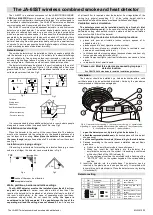
THE BLOCKS
43
The Chorus/Flanger Block
The Chorus block is based on the heritage of the
TC 2290 Dynamic Delay and 1210 Chorus/Flanger.
The Chorus/Flanger block
A Chorus/Flanger is basically a short delay that gets
modulated by an LFO. The difference between Chorus and
Flanging is the Feedback of the Flanger. That is the
parameter that gives you that classic mid-range tone. The
modulation of the short delay gives very small variations in
pitch, these pitch changes blended with the direct sound
gives you the Chorus sound, while the modulated signal
alone will give you a Pitch modulator also known as Vibrato.
CHORUS/FLANGER
Classic Chorus
The Classic Chorus uses a relationship between Speed and
Depth called the Golden Ratio. The G-Force inherited this
feature from the TC 2290.
Speed
The speed of the Chorus, also known as Rate.
Tempo
The Tempo parameter sets the relationship to the global
Tempo e.g. if you set it to 1/4T you will get quarter note
triplets of the tapped tempo. 1/4 equals the BPM (tapped
Tempo).
If you select “Ignored” the current parameter will use the
Preset value and will not be affected by the Global Tempo.
Depth
Adjusts the depth of the Chorus, also known as Intensity.
Mix
Mix between direct sound and effect.
In Level
Controls the input level of the block.
Mute mode
See Mute mode in the introduction of this chapter.
Create a Vibrato by setting the Mix at 100%,
Depth at 5-10% and Speed to 1-2 Hz.
Advanced Chorus
Advanced Chorus adds some extra parameters like LFO
Phase and Curve.
Speed
The speed of the Chorus, also known as Rate.
Tempo
The Tempo parameter sets the relationship to the global
Tempo e.g. if you set it to 1/4T you will get quarter note
triplets of the tapped tempo. 1/4 equals the BPM (tapped
Tempo).
If you select “Ignored” the current parameter will use the
Preset value and will not be affected by the Global Tempo.
Depth
Adjusts the depth of the Chorus, also known as Intensity.
Delay
As described earlier, a Chorus/Flanger is basically a Delay
being modulated by an LFO. This parameter makes it
possible to change the length of that Delay. A typical Chorus
uses delays at approximately 10 ms, while a Flanger uses
delays at around 5 ms.
Golden Ratio
Sets the Golden Ratio between Speed and Depth On/Off. If
you want to create wild Chorus sounds you may want to turn
the Golden Ratio off.
Phase Reversed
Reverses the phase of the right channel, but only on the
effect signal. This function makes the stereo image much
wider.
LFO Curve
Sets the curve of the LFO. Choose between: Sine or
Triangle.
The most commonly used waveform in Chorus is Sine. (see
curve figures in Tremolo)
LFO Phase
An LFO phase change causes a small delay in one of the
waveform starting points. This means that left and right
outputs start the current waveform at two different points.
Example: If LFO phase is set 180º, left and right will be
exactly opposite.
Summary of Contents for G-Force
Page 1: ...G Force GUITAR EFFECTS PROCESSOR USER S MANUAL...
Page 2: ...2...
Page 4: ...4...
Page 32: ...UTILITY This page is intentionally left blank...
















































